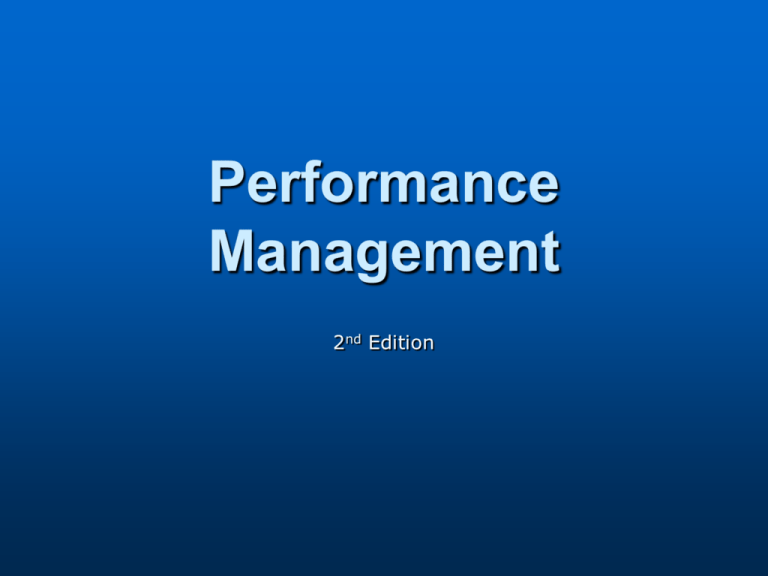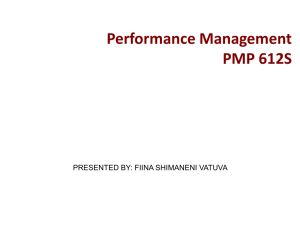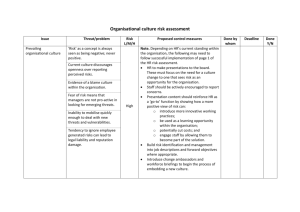Performance Management
advertisement

Performance Management 2nd Edition Performance Management and Reward Systems in Context Overview Definition of Performance Management (PM) The Performance Management Contribution Disadvantages/Dangers of Poorly Implemented PM Systems Definition of Reward Systems Aims and Role of PM Systems Characteristics of an Ideal PM System Integration with Other Human Resources and Development Activities Definition of Performance Management (PM) Definition of PM 1. Continuous Process of Identifying Measuring Developing The performance of individuals and teams Definition of PM (continued) and 2. Aligning performance with Strategic Goals of the organization Performance Management is NOT performance appraisal PM is NOT performance appraisal Performance Management • Strategic business considerations • Driven by line manager • Ongoing feedback So employee can improve performance PM is NOT performance appraisal Performance Appraisal • Driven by HR • Assesses employee Strengths & Weaknesses • Once a year • Lacks ongoing feedback Contributions of Performance Management Contributions of Performance Management For Employees Clarify definitions of job success criteria Increase motivation to perform Increase self-esteem Enhance self-insight and development Contributions of Performance Management For Managers Communicate supervisors’ views of performance more clearly Managers gain insight about subordinates Better and more timely differentiation between good and poor performers Employees become more competent Contributions of Performance Management For Organization/HR Function Clarify organizational goals Facilitate organizational change Fairer, more appropriate administrative actions Better protection from lawsuits Disadvantages/Dangers of Poorly-implemented PM Systems Disadvantages/Dangers of Poorly-implemented PM Systems For Employees Lowered self-esteem Employee burnout and job dissatisfaction Damaged relationships Use of false or misleading information Disadvantages/Dangers of Poorly-implemented PM Systems For Managers Increased turnover Decreased motivation to perform Unjustified demands on managers’ resources Varying and unfair standards and ratings Disadvantages/Dangers of Poorly-implemented PM Systems For Organization Wasted time and money Unclear ratings system Emerging biases Increased risk of litigation Reward Systems Reward Systems Definition Set of mechanisms for distributing Tangible returns and Intangible or relational returns As part of an employment relationship Reward Systems Tangible returns Cash compensation Base pay Cost-of-Living & Contingent Pay Incentives (short- and longterm) Reward Systems Tangible returns (continued) Benefits, such as Income Protection Allowances Work/life focus Reward Systems Intangible returns Relational returns, such as Recognition and status Employment security Challenging work Learning opportunities Returns and Their Degrees of Dependency on the Performance Management System Returns with Low Dependency on the Performance Management System Cost of Living Adjustment Income Protection Returns with Moderate Dependency on the Performance Management System Work/Life Focus Allowances Relational Returns Base Pay Returns with High Dependency on the Performance Management System Contingent Pay Short-term Incentives Long-term Incentives Purposes of PM Systems Purposes of PM Systems: Overview Strategic Administrative Informational Developmental Organizational maintenance Documentational Strategic Purpose Link individual goals with organization’s goals Communicate most crucial business strategic initiatives Administrative Purpose Provide information for making decisions re: Salary adjustments Promotions Retention or termination Recognition of individual performance Layoffs Informational Purpose Communicate to Employees: Expectations What is important How they are doing How to improve Developmental Purpose Performance feedback/coaching Identification of individual strengths and weaknesses Causes of performance deficiencies Tailor development of individual career path Organizational Maintenance Purpose Plan effective workforce Assess future training needs Evaluate performance at organizational level Evaluate effectiveness of HR interventions Documentational Purpose Validate selection instruments Document administrative decisions Help meet legal requirements An Ideal PM System: 14 Characteristics 1. 2. 3. 4. 5. 6. 7. Congruent with organizational strategy Thorough Practical Meaningful Specific Identifies effective/ ineffective performance Reliable An Ideal PM System: 14 Characteristics (continued) 8. 9. 10. 11. 12. 13. 14. Valid Acceptable and Fair Inclusive Open (No Secrets) Correctable Standardized Ethical Congruent with organizational strategy Consistent with organization’s strategy Aligned with unit and organizational goals Thorough All employees are evaluated All major job responsibilities are evaluated Evaluations cover performance for entire review period Feedback is given on both positive and negative performance Practical Available Easy to use Acceptable to decision makers Benefits outweigh costs Meaningful Standards are important and relevant System measures ONLY what employee can control Results have consequences Evaluations occur regularly and at appropriate times System provides for continuing skill development of evaluators Specific Concrete and detailed guidance to employees • What’s expected • How to meet the expectations Identifies effective and ineffective performance Distinguish between effective and ineffective • Behaviors • Results Provide ability to identify employees with various levels of performance Reliable Consistent Free of error Inter-rater reliability Valid Relevant (measures what is important) Not deficient (doesn’t measure unimportant facets of job) Not contaminated (only measures what the employee can control) Acceptable and Fair Perception of Distributive Justice • Work performed Evaluation received Reward Perception of Procedural Justice • Fairness of procedures used to: Determine ratings Link ratings to rewards Inclusive Represents concerns of all involved • When system is created, employees should help with deciding What should be measured How it should be measured • Employee should provide input on performance prior to evaluation meeting Open (No Secrets) Frequent, ongoing evaluations and feedback 2-way communications in appraisal meeting Clear standards, ongoing communication Communications are factual, open, honest Correctable Recognizes that human judgment is fallible Appeals process provided Standardized Ongoing training of managers to provide Consistent evaluations across • People • Time Ethical Supervisor suppresses self-interest Supervisor rates only where she has sufficient information about the performance dimension Supervisor respects employee privacy Integration with other Human Resources and Development Activities PM provides information for: • Development of training to meet organizational needs • Workforce planning • Recruitment and hiring decisions • Development of compensation systems Quick Review Definition of Performance Management (PM) The Performance Management Contribution Disadvantages/Dangers of Poorly Implemented PM Systems Definition of Reward Systems Aims and Role of PM Systems Characteristics of an Ideal PM System Integration with Other Human Resources and Development Activities





